Introduction: In this article, Gena Philibert-Ortega writes about an unexpected source of family history information: those “25 Years Ago” newspaper columns. Gena is a genealogist and author of the book “From the Family Kitchen.”
Have you seen those newspaper articles that provide snippets of what was happening decades prior, such as 25, 50, or 100 years ago? These newspaper articles provide historical highlights for global or local events over the decades.
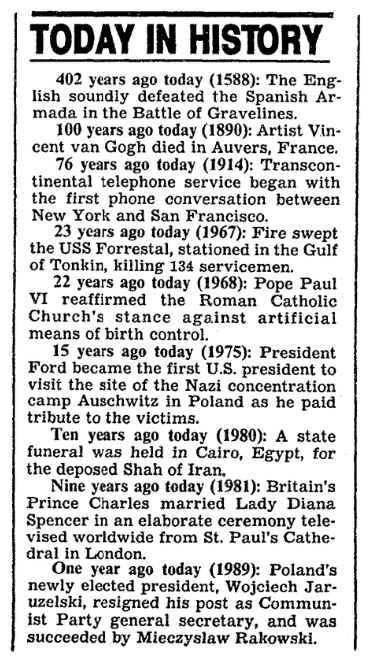
But what does this have to do with genealogy? Sure, it’s nice to have that historical information – but couldn’t you find the same thing with a few Google searches?
In some cases, smaller city and town newspapers run these types of articles – but instead of worldwide historical events such as inventions, wars, and the deaths of political and military figures, they print what was happening to the people of the community the paper serves. These mentions can include everything from marriages and deaths to local history and events.
What this provides for you as a researcher is one more opportunity to find information where you least expect it. I was recently lecturing to a group of family historians on the importance of newspaper research, and a few participants mentioned finding information including a death date and a maiden name by reading these “X Years Ago Today” newspaper articles.
These articles can also be important in cases where your access to that specific newspaper from that earlier date, decades previous, is not available online.
Search Tip: Adding a date range to your search can be an important technique to focus and narrow your search for an ancestor with a common name, but in the case of these “Today in History” articles an ancestor might be mentioned 100 years after they died. Keep that in mind as you craft possible newspaper searches.
25 Years Ago
Here’s one example of the usefulness of this type of newspaper article. The Trenton Evening Times on 6 February 1921 published this column, “Trenton 25 Years Ago,” which is a “Review of the Happenings of That Period, with Comments on the People and Incidents That Made Up the News of the Day.”
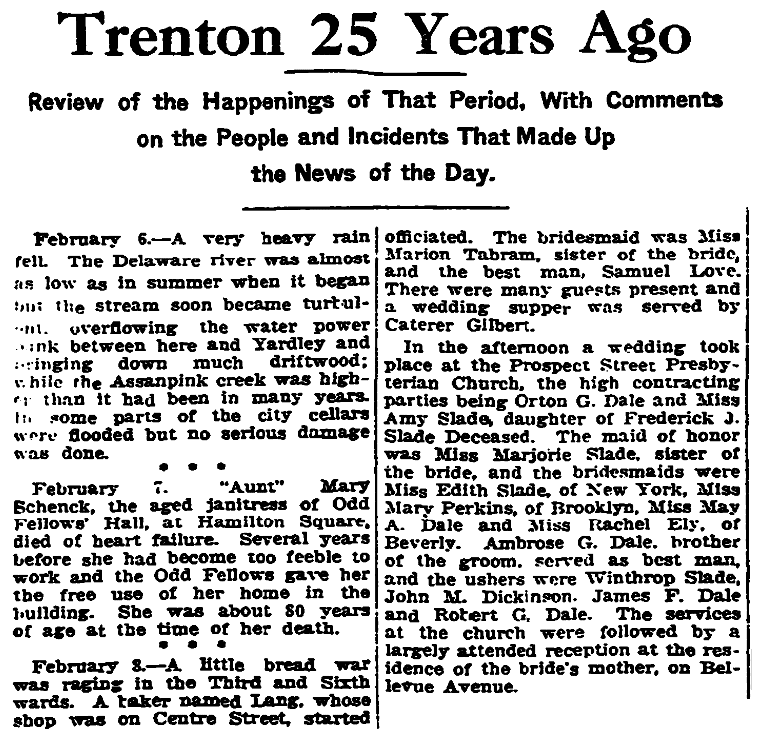
Look at that entry for February 7, a mention of a local death.
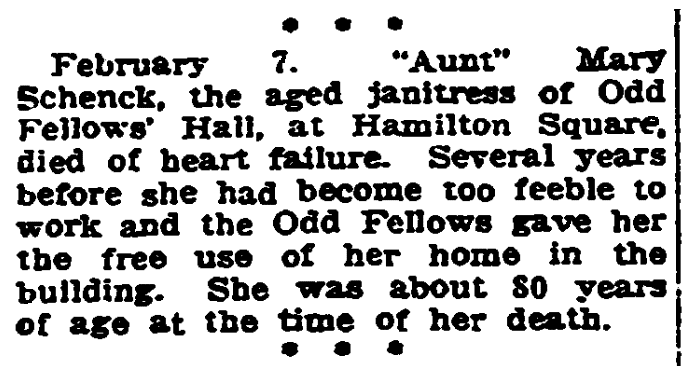
So, what did you learn about Mary Schenck? She was about 80 years of age when she died, placing her birth at about 1816. She worked as a “janitress” at the Odd Fellows Hall, but when she became too “feeble to work” she lived there at the building which was at Hamilton Square. While her birth year is too early for a New Jersey birth certificate (if that’s where she was born), you should be able to find a death certificate for her.
What’s nice is that not only do we have some information to follow up on, but we also have her occupational information – which is often difficult to find. In addition, if that group of Odd Fellows kept records, there’s a chance that the decision to allow her to live there will be mentioned. All this information for a single woman who appears to have been impoverished in 1896! Here she is being mentioned in 1921. These types of articles can remind the reader of the important people in history, but they can also mention the everyday people in the community.
It’s important to note that this edition of “25 Years Ago” also includes details of four weddings with the names of the couples and their parents. It’s possible that the newspaper might also have articles about these couples’ 25th wedding anniversaries, if applicable.
50 Years Ago
This 1914 newspaper article from Aberdeen, South Dakota, is a little different from the standard article detailing what happened “on this day” decades earlier. In this case, in honor of Lincoln’s birthday, it asks Civil War veterans to share what they were doing on February 12th, 50 years ago.
One of the men listed was “City Auditor F. W. Raymond of the Thirty-sixth Illinois was stationed at Columbus, Ky., in the position of chief clerk in the post quartermaster’s department fifty years ago today.”
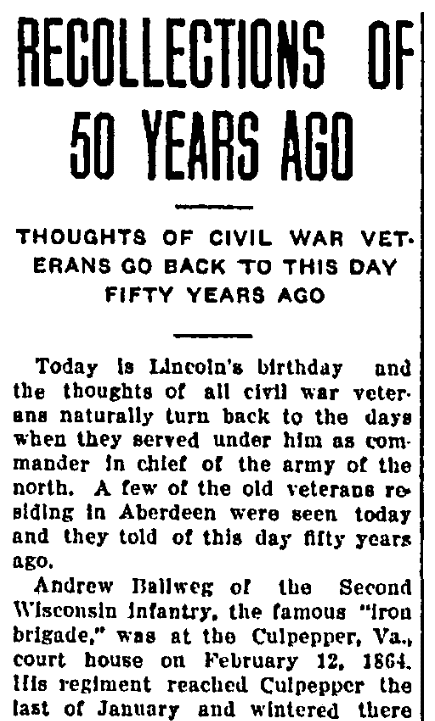
Fifty years after the Civil War, here we find mention of these veterans and their service. If you were researching them, not only do you now have this military information to follow up on but if you weren’t sure of when they died, you know that they were at least living on 12 February 1914 and could search after that date.
10, 25, 50, 100 Years Ago Today
A look back in time for a specific time frame is great, but what about multiple jumps back in time?
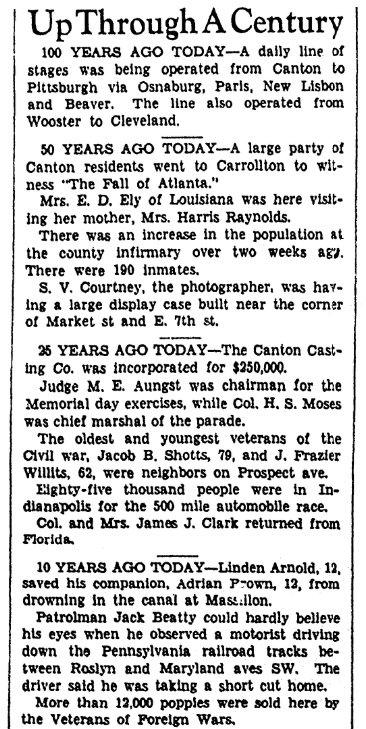
This Canton, Ohio, “Up through a Century” newspaper column reports that 10 years previously, 12-year-old Linden Arnold saved his friend Adrian Brown from drowning in the canal, while 25 years ago the “oldest and youngest veterans of the Civil War, Jacob B. Shotts, 79, and J. Frazier Willits, 62, were neighbors on Prospect ave.”
And it would seem nothing is insignificant for these columns, such as a short mention that Mrs. E. D. Ely of Louisiana was visiting her mother, Mrs. Harris Reynolds, 50 years ago. The importance of this for a researcher is that “Reynolds” could be Mrs. E. D. Ely’s maiden name – emphasis on “could be” since Harris Reynolds may not be her father but instead her mother’s subsequent husband. Finally, the 100 years ago fact in this column details the stage lines of the time, which is a helpful clue if you’re trying to figure out how your ancestor got from point A to Point B in Ohio.
What Happened 50 Years Ago?
It’s easy to focus your search on the specific years that your ancestor was alive in order to find a mention of a marriage license application or obituary – but in reality, other lesser-known newspaper articles may hold the information you need long after your ancestor died. People love nostalgia, and newspapers deliver this with lists of what happened in their community’s history. Those persons mentioned in these articles might just include your ancestor or something that affected their life.
Come do a search in GenealogyBank’s Historical Newspaper Archives today and see what you might find!

I enjoyed the article about “what happened years ago on this date” by Gena Philibert-Ortega. I always learn something from her bag of tricks and EXPERTISE. Thank you.
Thank you Cindy! I appreciate it.–Gena
I have among the precious photos of my family a few snapshots taken at the base of the Huey P. Long Bridge in New Orleans. No date or event was written on the back, of course. One of them was of a steam locomotive traversing that span. One day, the New Orleans Times Picayune published, in its regular weekly “Picture Out of Our Past” a picture of a steam train going over the same bridge – on Opening Day. My mother and aunt, little girls then, were on an outing with their father to watch the very first train to cross over the Mississippi at New Orleans, and was not only able to date the photos but also got the story of the event. Keep looking. The more you look, the more you might “accidentally” find something interesting or helpful!
Great story and advice Ken! Thanks for sharing. –Gena